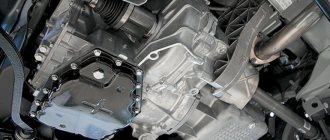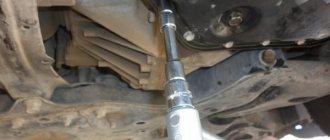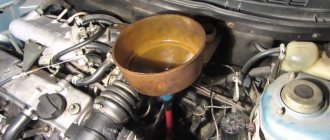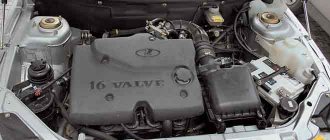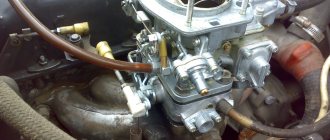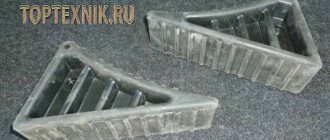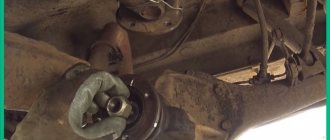All manual gearboxes of the Passat B6 are reliable. Of course, all other things being equal, gearboxes paired with diesel units have a more difficult time. During urban use, the dual-mass flywheel can withstand about 150-170 thousand kilometers. The fact that it requires replacement will be made clear by knocking noises in the area of the rear wall of the power unit. There are no serious complaints about the classic automatic transmission Aisin TF60SN series. The American version of this box is equipped with a full-fledged external cooling radiator.
When changing oil in a manual transmission, you need a product with a viscosity of 75w90 standard GL 4. You can choose semi-synthetic oil with less aggressive additives for older gearboxes.
On the European version, the overheating protection is worse and consists of a small oil heat exchanger installed on the box body.
At the same time, Volkswagen officially declares that the working fluid in the automatic transmission does not require replacement, which only increases the risk of overheating.
The Aisin company gives opposite recommendations and states that it is necessary to change the oil in the gearbox every 60 thousand kilometers.
Compare the transmission oil when draining waste from the gearbox. Therefore, it is definitely necessary to change the oil in the transmission.
If the automatic transmission is still alive, it makes sense to invest in installing an external cooling radiator. Before a major overhaul, the Aisin automatic transmission will last at least 300 thousand kilometers.
If the Passat is equipped with a DQ200 robotic transmission, famous for its problematic mechatronics and clutches, then it has been repaired. But if 10 years ago repairing a “robot” was very expensive, now the price tag seems humane. If the rest of the chosen car is good, then you can take a risk. The DQ250 robotic 6-speed gearbox with wet clutches is good.
Changing automatic transmission oil VW Passat B6 (1.8 TSI BZB)
Reason for replacement: Oil was leaking through the oil seal (after it was replaced), as a result, the volume in the box decreased by 2 liters.
This led to an increase in temperature, burning of the clutches and burning of the oil. Photo and description here. The oil was changed using an automatic transmission 09G of a VW Passat B6 (automatic transmission with the letter designation KGV).
Similarly, replacement is carried out on boxes with a letter designation: for 1.6 l engines - 85 kW FSI together with HXK, JUB, KGS; for 2.0 l engines - 110 kW FSI together with HFT, HVW, HXJ, JUC, KGT; for 1.8 l power units - 118 kW TFSI together with JYY, KGV; for 2.0 l engines - 147 kW FSI together with HHP, HRN, JUD, JZV, KGU).
| Automatic gearbox 09G | ||||
| Letter designation | HXK JUB KGS | HFT HVW HXJ JUC KGT | JYV KGV | HHP HRN JUD JZV KGU |
| Engine | 1.6 l - 85 kW FSI | 2.0 l - 110 kW FSI | 1.8 l - 118 kW TFSI | 2.0 l - 147 kW FSI |
Such automatic transmissions are installed on VW cars - Beetle (since 2006), GOLF and GOLF PLUS (since 2004), Jetta (since 2006), PASSAT (since 2006), PASSAT CC (since 2009), POLO (since 2009), Touran (since 2003) Audi A3 (since 2004). Skoda - Fabia (since 2007), Octavia (since 2004), Rapid (since 2013), Roomster (since 2006), Superb (since 2008) ), Yeti (since 2014), Seat - Altea (since 2004), Ibiza (since 2006), Leon (since 2006), Toledo (since 2005) .).
Regulations for changing automatic transmission oil:
According to data from the ELSA program, the oil in these gearboxes is changed only when operating in a hot climate - 60 thousand km. Russia does not belong to hot climate countries and, accordingly, the oil does not need to be changed. We recommend changing it, as for countries with hot climates. Since the oil loses its properties under any operating conditions.
Reason for replacement in our case: About 2 liters of oil left the box through a leaking oil seal. Accordingly, overheating with burning of the clutches and burnt oil in the box.
Overview video of the process on an identical box
Typical problems
Often, during the operation of a car, various breakdowns occur, and the Volkswagen Passat B6 is no exception. When the vehicle travels a certain mileage (approximately 50-60 thousand km), the gearbox begins to malfunction, and malfunctions such as:
- The automatic transmission goes into emergency mode, as indicated by the icon on the dashboard.
- The occurrence of jerks when trying to change gear, as well as impacts and “kicks”.
Also, a fairly common problem in automatic transmissions is oil leakage and failure of the valve body, as well as wear and tear of other structural elements.
In any case, if a malfunction is detected, it is recommended to begin repairs as soon as possible in order to prevent the final failure of the automatic transmission and, as a consequence, its complete replacement.
How to change the oil in an automatic transmission Volkswagen Passat B6 with your own hands
The practice of operating a Volkswagen Passat B6 car proves that replacing the transmission fluid in an automatic transmission should be carried out at a mileage interval of 50,000 km. The duration of operation of the automatic transmission directly depends on the regularity of this procedure and the quality of the materials used. The frequency of lubricant changes, the selection of transmission substances, and the technical details of the process are related to the specific model of the Volkswagen Passat line.
When might an oil change be necessary?
Starting from the Volkswagen Passat B5 generation, the manufacturer recommends not changing the automatic transmission fluid. It is assumed that the transmission oil resource should be sufficient for the entire service life of the vehicle. However, due to many circumstances, replacing the lubricant may still be necessary.
The reasons for changing the oil are various violations of the automatic transmission operating modes:
Even with normal operation of automatic transmissions installed on cars of the 5th generation (Volkswagen Passat B5) and older, according to general advice, the oil is changed for the first time after 100,000 km. Then it is recommended to repeat this procedure every 50,000 km. And if one of the described symptoms occurs, the transmission fluid should be replaced earlier. Flushing the automatic transmission and changing the lubricant may be required during partial or complete repair of this unit.
Replacement frequency
Volkswagen does not recommend changing the fluid. This is due to the fact that factory lubricant is initially designed for the entire service life of the car. However, the manufacturer does not take into account the harsh Russian conditions, in which the fluid replacement schedule is reduced to 30-40 thousand kilometers. The sooner you change the oil, the better it will be for the gearbox. Under the influence of unfavorable factors, the fluid quickly loses its beneficial properties and is no longer able to cool the automatic transmission components, as well as prevent their premature wear. As a result, the gearbox will sooner or later fail if measures are not taken in a timely manner.
Signs that you need an oil change may include the following:
1. Jerks and unclear gear shifting 2. Drop in engine power 3. Noises, knocks and vibrations in the automatic transmission 4. When checking the condition of the oil, the fluid smells burnt and turns black over time
Which lubricant is best to use and how much is needed?
Before a planned or forced replacement is carried out, you need to stock up on transmission fluid. Only the original is strongly recommended for use. Its catalog number is G 052162A2.
However, such oil may not always be at hand, and even in sufficient quantities. Then, with extreme caution and accuracy, you can pour transmission fluid from other manufacturers into the Volkswagen Passat automatic transmission. These may be ESSO ATF LT 71141 or MOBIL LT 71141.
In any case, you can only use the oil that is recommended for automatic transmissions. As a last resort, turn to a series of universal oils. If problems arise with the Passat automatic transmission, Vavoline Max Life helps out.
Changing the lubricant in an automatic transmission is accompanied by the procedure of replacing the old filter with a new one. Taking into account this circumstance, it is better to acquire 9 liters of transmission fluid. The remainder can be used for topping up.
Step-by-step replacement instructions
If a complete oil change in an automatic transmission is a complex process, then a partial one is quite simple. It does not require special complex devices and can be produced independently.
Automatic transmission in Volkswagen Passat
- Before you start, it is recommended to warm up the car engine a little and then turn it off. The shift lever must be set to position “P”. After this, you can proceed directly to changing the oil.
- To gain access to the Passat B6 automatic transmission, you must first remove the engine protection housing.
- Next, unscrew the screw plug.
- We unscrew the drain tube and drain the waste liquid into some container.
- The next thing is to replace the filter. First, we take out the old filter and install a new one.
- Now install the drain tube and clamp it only with your hands for now.
- Fill in about three liters of oil and start the engine. Here you need to change gears, holding each gear for 5-10 seconds. At the same time, do not forget to hold the brake pedal. When all positions have been passed, turn off the engine.
- Now you need to add the remaining oil. In general, it will be necessary to fill the automatic transmission with the same amount as was drained.
- At the end, tighten the screw plug and install the protection.
That's it - it's done. This does not take much time, but can prevent serious car damage and expensive repairs.
Consumables, tools, accessories
If you will be replacing the transmission lubricant yourself, then you should take care in advance of a complete set of everything necessary for this procedure. Supplies you will need:
- transmission oil;
- pan gasket (catalog number 01V321371);
- sealing ring;
- automatic transmission filter (catalog No. 01V325429);
- gasoline for cleaning.
- set of hex keys;
- screwdriver and removable torx bits;
- torque wrench;
- thin tweezers;
- small diameter rubber pipeline for filling oil;
- container for draining waste substances;
- clean rags.
Other keys may be needed (for example, to remove protection). It is best to carry out work on replacing the transmission fluid in an automatic transmission in an equipped garage with an inspection pit.
The procedure for performing work independently
Completely replacing the lubricant in a Passat automatic transmission is not an easy process. It is possible to carry out a partial (incomplete) lubricant change independently and without complex special devices. But even a not completely updated transmission substance can have a beneficial effect on improving the operation of the automatic transmission.
Before starting work, it is recommended to warm up the engine and go through all gear modes at short intervals. Then the car is immobilized in the inspection pit. The shift lever is set to position “P”. And only after this they begin to directly change the oil.
Dismantling the pan and removing the filter
- To access the automatic transmission tray, you need to remove the protection. The drain plug is unscrewed from the bottom of the pan.
- A container is placed under the drain hole to collect waste liquid. Only part of the transmission substance will flow out through this hole.
- Hexagon (
 unscrew the fastening bolts to completely remove the pallet. There are magnets on the inside of the pallet. They are designed to catch metal particles that are formed as a result of wear of automatic transmission parts.
unscrew the fastening bolts to completely remove the pallet. There are magnets on the inside of the pallet. They are designed to catch metal particles that are formed as a result of wear of automatic transmission parts. - The degree of wear of the mechanism elements is assessed by the amount of metal products. An increased amount of chips indicates a possible serious breakdown. The inside of the tray cover is thoroughly washed and cleaned.
- The filter is removed, secured with 2 bolts.
- The wire tips from the control plate are removed from the connectors. The bundle of wires is released from fixation and taken to the side.
- It is important to remember in what position the automatic transmission selector lever is located. During the assembly process, the link must be installed in its original position (as before removal).
Control plate: removal and further disassembly
- Using torx screws, 17 bolts are unscrewed that secure the control plate. It is important to follow the order. According to the diagram, bolt No. 17 is first unscrewed. Then they move according to the principle of the reverse sequence to bolt No. 1.
- Carefully holding the stove, remove it from the box. The inside of the box is thoroughly cleaned of any remaining liquid.
- The control plate combines 5 components. Additionally, there is a massive plate inside. Underneath there are balls and jets. All these parts will need to be washed and dried.
- The components are disassembled after unscrewing the fastening bolts. They are of different lengths. Therefore, you need to remember or mark the location of each bolt.
- After removing the 4 components, you can approach the plate. It is removed and washed thoroughly. The dried plate should be placed near the stove. Use thin tweezers to carefully remove the balls, jets and springs. It is better to place them on the plate in places corresponding to the installation. All elements are washed in gasoline and wiped dry.
Automatic transmission assembly procedure
After drying or removing gasoline residues, the slab is assembled. It is necessary to strictly follow the order of installing small parts in the appropriate places:
- the control plate is mounted in place, fixed with bolts in the order from No. 1 to No. 17; the selector link is installed in the same place; wiring is connected and fixed; a new filter is installed; the pan gasket is changed (it is advisable to change the drain plug gasket); the pallet is fixed.
Filling the transmission substance
Filling of a new transmission substance is carried out in several stages:
- the bolt of the hole for filling the lubricant is unscrewed;
- prepare a liter container for the new liquid: you can use a plastic bottle with a rubber pipeline attached to the stopper;
- fresh liquid is poured from the prepared container in such an amount that it protrudes over the edge of the hole;
- The Passat starts, the gearbox lever is moved through all modes (no more than 2 seconds in each position);
- the engine is turned off, the fluid is added;
- The procedure is repeated once again to start the engine.
At the final stage, the amount of transmission fluid is brought to the desired level. To do this, the car engine starts and the gearbox lever is switched to parking mode (“P”). The liquid in the box needs to be heated to 35–45°. A low or high temperature will lead to underfilling of the transmission fluid or to its overfilling. The correctness of the work will be confirmed by the elimination of shocks or delays in the operation of the automatic transmission.
Source
Automatic transmission repair B6
If the oil change in the Volkswagen Passat B6 automatic transmission is carried out consistently, the risk of problems with the system is minimal. Otherwise, various breakdowns may occur. Below is a list of the most common ones. Write in the comments which of them you have encountered in real life.
Hydraulic unit
If shocks occur when shifting 2-3, 4-5 and 5-6 gears, you need to pay attention to the condition of the valve body. The manufacturer equips this unit with fairly weak solenoids. In addition, chips and other deposits circulating in the gearbox quickly clog this part of the transmission. A functioning problem arises if the oil in the Volkswagen Passat B6 gearbox has not been changed for a long time.
First of all, hydraulic plates fail. After them, the valves begin to jam. In this case, the solenoids open late. To diagnose such a problem, service stations in Moscow use appropriate stands to quickly detect the cause of the breakdown.
For repair you need:
- drain the oil from the system;
- remove the filter;
- unscrew the valve body bolts and dismantle it;
- clean the valves;
- replace solenoids;
- dry the slabs.
After completing the above steps, you need to reassemble the device.
Overheat
The main problem with overheating of automatic transmissions is the low level of pressure in their system. This malfunction occurs due to two most common reasons, such as:
- insufficient oil volume;
- oil pump failure.
In the vast majority of cases, changing the oil in the Volkswagen Passat B6 gearbox eliminates the cause of overheating. You must not forget to clean the pipes and hoses from burning. Otherwise, you will have to replace the oil filter or pump. Sometimes it is necessary to replace the radiator or install an additional one.
Planetary gear repair
Sometimes when shifting gears of the V6 automatic transmission, jerks and jolts occur. In this case, it is necessary to remove the automatic transmission and inspect the planetary gear. It is likely that part of the clutches in it burned out. It is best to replace them in sets.
All friction discs of robotic transmissions have special notches. They must be installed in the direction of rotation. They make the oil in the box circulate much faster.
Torque converter
In order to repair the Volkswagen Passat torque converter, we recommend cutting it into two parts. This is the only way to get to the inside of the device and eliminate failed parts.
Before you start work, you need to fix the torque converter in a vice. After all manipulations have been completed, the device should be welded with a sealed seam.
Fork and clutch discs
In the Volkswagen Passat, the automatic transmission is equipped with special forks and discs. Their main purpose is to simplify the process of changing gears from even to odd numbers.
If at least one fork is deformed, the transmission may fail when the vehicle accelerates sharply. In this case, a complete replacement of damaged spare parts is required. Such problems arise when the mileage of the Volkswagen Passat is already quite significant.
